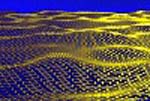
Graphene has engendered high expectations whereof its extreme properties depend on the fact that it consists of a single sheet of carbon atoms.
However the attraction forces between the atoms cause the sheets to be drawn to each other. One solution is to add atomic hydrogen between the layers.
The researchers’ calculations show that the hydrogen at a given concentration affects the atomic ‘van der Waals forces’ and becomes repulsive instead of attractive. The result is that graphene sheets repel each other and float freely just a few nanometres apart (an example of the so-called quantum levitation).
Professor Bo E. Sernelius, who conducted the study with his former doctoral student Mathias Bostrom, identifies several possible applications of the discovery:
-Storage of hydrogen as vehicle fuel
-Creation of a single graphene sheet by peeling them from a pile that has grown on a substrate of silicon carbide; a method developed at Linköping University
-Repulsive forces are ideal for the manufacture of friction-free components on a Nano scale, for example, robots and sensors for medical purposes
In the present study the researchers began with two ‘undoped’ sheets of graphene on a substrate of silicon dioxide (silica). The starting position is the van der Waals attractive forces and the sheets are compelled closer together. However once atomic hydrogen is added, repulsive forces arise. A similar effect was observed using other gases such as molecular hydrogen (H2) and helium.
Graphene is a two-dimensional material, which means that it retains a very special character. It is flexible, transparent, stronger than a diamond and has a superior ability to conduct electric current. In 2010 Andre Geim and Konstantin Novoselov received a Nobel Prize in Physics because for the first time ever they succeeded in producing stable flakes of material.



